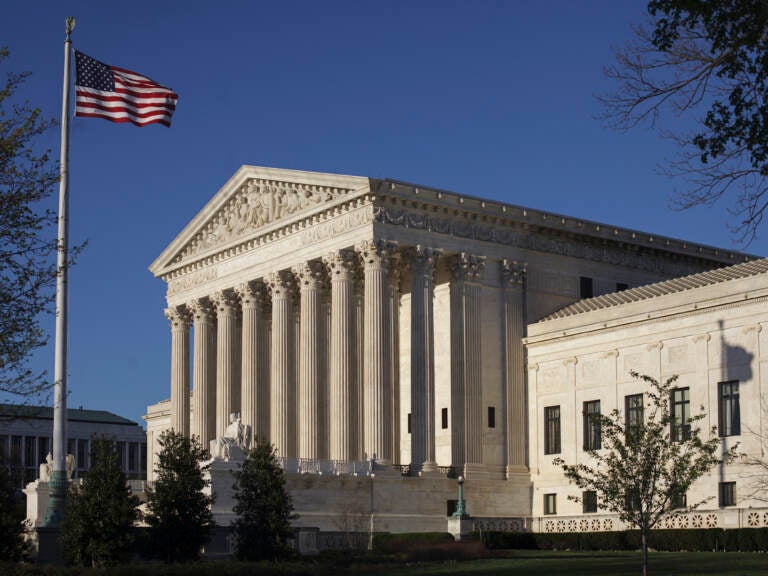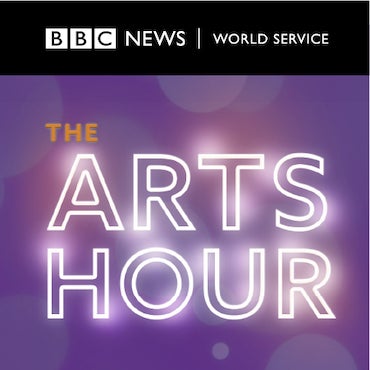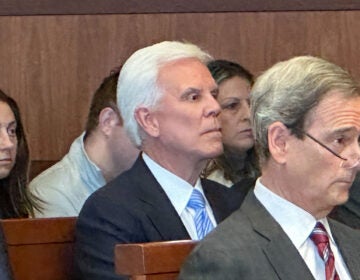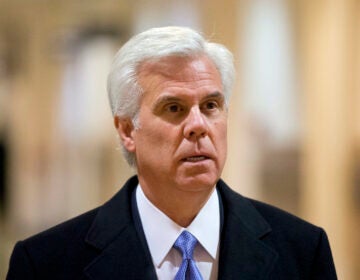The Supreme Court’s conservatives cook up a stew of abortion, guns, religion and more

FILE - In this April 4, 2017 file, the Supreme Court in Washington. (AP Photo/J. Scott Applewhite)
For the justices of the U.S. Supreme Court, Monday marks the first time nearly all of them will gather together in the courtroom since the lockdown a year and a half ago. But if some of the justices greet the new term with great anticipation for a new conservative legal era, others likely are facing the term with dread.
The docket for this term is a humdinger with major cases involving the biggest social issues of the day: abortion, guns, separation of church and state, and potentially affirmative action in higher education.
“It seems like every few years, we say we’re going to see radical conservative takeover of the Supreme Court in American law,” says Tom Goldstein, publisher of SCOTUSblog. But this time, he adds, “We really mean it. ”
As Goldstein observes, the court has changed composition with the addition of three Trump appointees; it has six really solid conservative members and it has decided to put on the docket “front and center, massive social issues that it has ducked in the past because it couldn’t get five solid conservative votes to change the law. And now it looks like it may be time.”
The issues before the court are not a haphazard collection. Rather, they were deliberately selected by the court’s new conservative supermajority with an eye to chipping away, hacking away, or outright overruling nearly 50 years’ worth of abortion decisions, for instance, or expanding other decisions, like those protecting gun rights and religious rights.
“We may have come to a turning point”
No outcome, of course, is a sure bet, but it isn’t just activists on one side or another who seem rattled. Listen, for instance, to the normally noncommittal Irv Gornstein, the longtime executive director of the Supreme Court Institute at Georgetown University Law Center.
“I think we may have come to a turning point. Within a span of two to three terms, we see sweeping right-sided decisions over left-sided dissents on every one of the most politically divisive issues of our time,” he says. “Voting, guns, abortion, religion, affirmative action.”
The perception of the court may be “permanently altered,” he warns.
Gorstein adds: “It is all well and good for justices to tell the public that their decisions reflect their judicial philosophies, not their partisan affiliation, but if right-side judicial philosophies always produce results favored by Republicans, and left-side judicial philosophies always produce results favored by Democrats, there is little chance of persuading the public there is a difference between the two.”
Abortion rights may be in peril
Three of the court’s nine members have preached the nonpartisan message in speeches over the last month, but it doesn’t seem to be working. The court, in two major and reputable polls, has taken a big hit. A Gallup Poll, for instance, found that public approval of the court’s job performance slid to a new low of 40%, including “less than a majority of Republicans, Democrats and Independents.”
Pollsters indicate that some of this precipitous decline occurred after the court allowed a Texas law banning all abortions after six weeks to go into effect. Because the law was written to make it difficult to be challenged, the five justices in the majority said this was not the time to examine it. But that did not change the fact that the court, through its decision not to intervene, allowed almost all abortions to be banned in Texas for the foreseeable future.
At the same time the court is scheduled to hear arguments in December testing a Mississippi law that bans abortions after 15 weeks. That time frame is a direct challenge to Roe v. Wade and subsequent decisions, which declared that women have a constitutional right to terminate a pregnancy up to the point when the fetus can survive outside the womb — at about 24 weeks.
There are multiple ways the court could decide the Mississippi case: narrowly or broadly. Narrowly might stave off a major backlash in public opinion. But however the court rules to restrict abortion rights, the effect of those steps could be analogous to what happens to a frog tossed into water as it heats up on a stove. He doesn’t know when he’s cooked.
The court revisits Second Amendment rights
If abortion represents nearly a half-century of Supreme Court precedents, guns do not. In 2008, the court ruled for the first time that people have a constitutional right to have a gun in their homes for self-defense. But beyond that principle, for all practical purposes, the court went silent. Now, for the first time in more than a decade, the court has accepted a major challenge to existing gun laws. The case was brought by gun owners against a New York law that requires a person who wants to carry a gun outside the home to get a special license, issued at the discretion of local authorities, after a showing that there is a “proper cause,” or need for carrying the gun. New York turned down the gun owners in this case because it said they did not have any special need to carry weapons outside the home for self-defense.
Supreme Court advocate Roman Martinez notes that the text of the Second Amendment does protect the right to keep and bear arms. But he also points to the historical record dating back to the time of the founding. New York state, he says, has “actually put forward a lot of evidence showing that really there were these restrictions on the right to carry arms outside of the home” long before the modern era.
The court is friendly to religious rights groups
After guns this term, there is religion. In particular, restrictions on taxpayer aid to religious schools. Before the court is a case from Maine that presents the issue rather starkly. Maine is a basically rural state. It has about 260 so-called administrative districts, tiny towns. Of those, more than half are too small to have public schools. But Maine law requires the towns to provide an education for all minors. Under the state law, the towns can contract with a nearby public school or private school to take their students, or the town can pay the tuition at a public or private school that a parent chooses. There is one exception. Tuition can only be paid to a nonsectarian school, so that taxpayer dollars are not used to fund religious education.
For generations, the Supreme Court did erect a high wall of separation between church and state when it came to state funding. But as the court grew more conservative, it increasingly viewed these restrictions as discriminatory.
“It’s going to be difficult for Maine to make a compelling case in court that it has the kind of interest that’s going to get past this nondiscrimination principle,” says former Solicitor General Jeffrey Wall, who served in the Trump administration.
SCOTUSblog’s Goldstein notes that the conservative justices could face competing concerns this term. One is that if public lack of confidence in the court as an institution grows, the other two branches could launch a counter-revolution to change the structure and makeup of the court. That would seem to be a long way off, for now. But as Goldstein points out, “On the other hand, the conservatives feel very strongly about this stuff. They really do think that Roe was wrongly decided, that there are too few gun rights, and there’s too much separation between church and state.”
9(MDAzMzI1ODY3MDEyMzkzOTE3NjIxNDg3MQ001))




